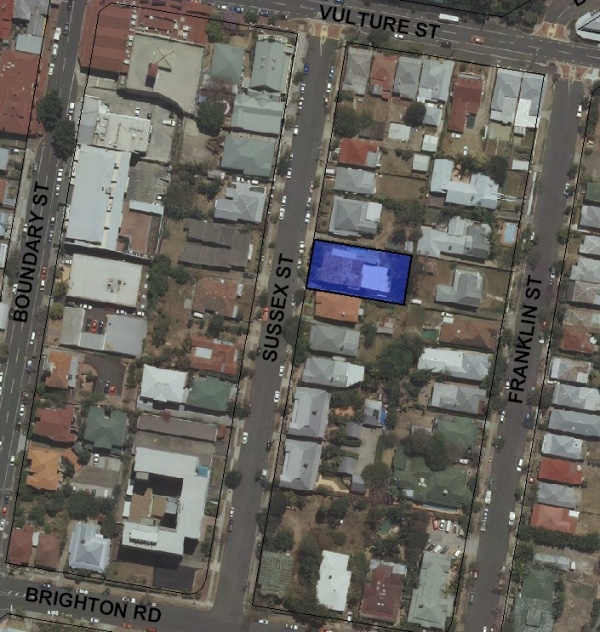Addresses
Type of place
House
Period
Victorian 1860-1890
Style
Queenslander
Addresses
Type of place
House
Period
Victorian 1860-1890
Style
Queenslander
‘Norwich’, constructed in 1878, was one of the first houses to be built in Sussex Street and is a good example of an 1870s middle class dwelling. From 1905 until 1912 it was home to well-known Queensland politician, explorer, journalist and newspaper editor, Archibald Meston.
Also known as
Cambanora
Lot plan
L40_RP11750
Key dates
Local Heritage Place Since —
Date of Citation —
Construction
Roof: Corrugated iron;Walls: Timber
People/associations
Archibald Meston (Occupant)Criterion for listing
(A) Historical; (H) Historical associationInteractive mapping
Also known as
Cambanora
Lot plan
L40_RP11750
Key dates
Local Heritage Place Since —
Date of Citation —
Construction
Roof: Corrugated iron;Walls: Timber
People/associations
Archibald Meston (Occupant)Criterion for listing
(A) Historical; (H) Historical associationInteractive mapping
History
The house at 16 Sussex Street, ‘Norwich’ is one of the oldest houses in this street. Hugh Hamilton purchased the land from land speculator William Steele in 1877. It was initially part of an allotment granted to Thomas Grenier in 1856. The neighbouring house, ‘Carnoch’ at 14 Sussex Street, was also part of this original grant. The two houses were constructed in the same year, 1878, and were the first to appear on the east side of Sussex Street. Together they form part of a mini historical precinct. Title Deeds indicate that a £250 mortgage was obtained to construct ‘Norwich’ in 1878, while post office directories show that the owner, Hugh Hamilton, occupied it until 1885-86.
In 1888 ownership was transferred to Joshua Bailey, a Wickham Street tailor in Fortitude Valley, who rented the house to the Reverend John Horsley. It was while Horsley was living there that the house was initially referred to as ‘Norridge Villa’. Directories suggest that the house be used primarily as a rental dwelling by its owners until the early 1900s.
In 1905 it was purchased by the politician, journalist and explorer, Archibald Meston, who renamed it ‘Cambanora’ for the duration of his stay. Born in 1851 in Aberdeenshire, Scotland, Meston represented Rosewood in the Queensland Legislature from 1878-1882 and Cook in 1907. By the 1890s after a period working as a journalist and editor of the Townsville Herald and Toowoomba Chronicle as well as sugar cane plantation owner, Meston was commissioned to prepare recommendations for the improvement of Aborigines’ welfare in Queensland. His proposals were subsequently embodied in the Aboriginals Protection Act 1897. While Meston was resident at ‘Cambanora’ he became Chief Protector of Aboriginals in the Southern Region. Meston also involved himself in scientific explorations of the time. Among others, he was leader of the Queensland Government’s expedition to the Bellenden Ker Range where he found a new plant of the mangosteen family that was named Garcinia mestonii in his honour. He was author of Geographic History of Queensland (1895), Scheme for the Improvement of Aborigines (1895) and The Sacred Ibis (1902).
The property passed through various owners and tenants throughout the latter part of the 1900s until Alfred Bennett purchased it in 1912 and ‘Norwich’ became associated with the Bennett family until the early 1950s. Noel Hall then purchased the property for his wife Doreen, who lived there until 1972. The property once again changed hands a number of times through the 1970s and 1980s.
Description
‘Norwich’ survives with its essentially pyramidal shaped corrugated iron roof, the shallow eaves of which are supported on paired ornate timber brackets. The timber boarding on the house is relatively deep, a characteristic often associated with these early houses.
The front verandah has a concave corrugated iron roof and balustrading with diagonal members. The verandah posts are spaced symmetrically but unevenly across the front of the building, dividing it into five bays. One is defined by a verandah post to each side of the entry door, and the two to either side of a similarly small proportion, while the outside ones are quite large. Solid timber brackets of varying angle span to the centre of each bay below the eaves line.
The entry door is a panelled timber door with a central doorknob. Windows are located behind the wider bays of the verandah. The front fence and entry stair is very solid in comparison to the light-weight timber structure of the building itself. Large rendered posts topped by moulding, widely spaced, extend up to a common level.
A solid portion of fence between these posts retains earth above footpath level, and above the ground level between the posts are cast iron bars topped by arrowheads as infill. A gate is made in a similar fashion, and stands in front of a concrete stair, which extends up to the verandah level entry.
Statement of significance
Relevant assessment criteria
This is a place of local heritage significance and meets one or more of the local heritage criteria under the Heritage planning scheme policy of the Brisbane City Plan 2014. It is significant because:
References
-
Brisbane City Council Water Supply and Sewerage Detail Plans
-
Department of Natural Resources, Queensland Certificates of Title and other records, Environmental Protection Agency
-
Evans, Ray, Saunders, Kay & Cronin, Kathryn, Race Relations in Colonial Queensland, (Brisbane: University of Queensland Press, 1993
-
JOL Estate Map Collection and photographic collection
-
Lawson, Ronald 1973, Brisbane in the 1890s: A Study of an Australian Urban Society, University of Queensland Press, St. Lucia
-
McKellar's Map of Brisbane and Suburbs. Brisbane: Surveyor-General’s Office, 1895
-
Pike, Douglas, ed, Australian Dictionary of Biography 1851-1890, Vol 5, Melbourne University Press, Melbourne, 1974
-
Waterson, D.B., A Biographical Register of the Queensland Parliament 1860-1929, Australian National University Press, Canberra, 1972
-
Watson, Donald and Judith McKay. Queensland Architects of the 19th Century: A Biographical Dictionary. Brisbane: Queensland Museum, 1994
Citation prepared by — Brisbane City Council (page revised September 2020)

